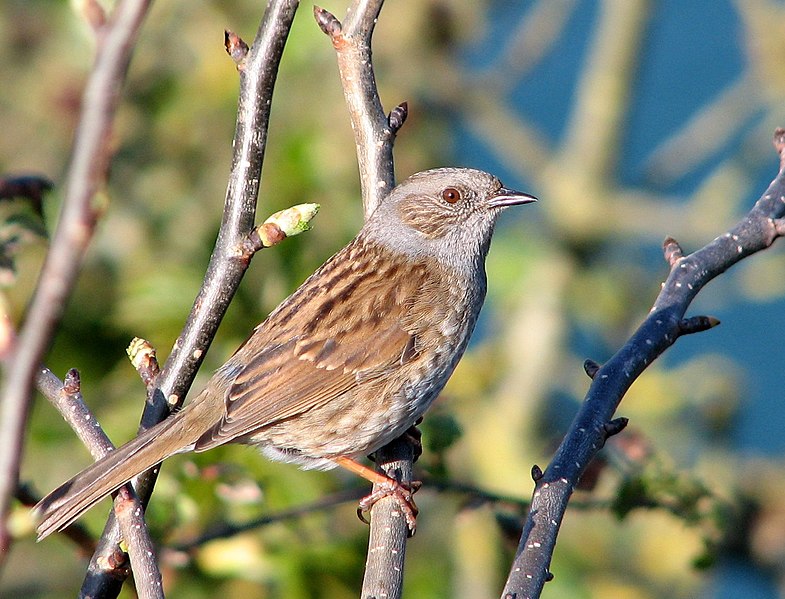Dunnock (Prunella modularis)
Measurements: 14.5 cm long.
The Dunnock, also known helpfully but not euphoniously as the Hedge Accentor, is the best studied member of its small family. It is also the only one to have forsaken the mountains to adopt lowland woodland, scrub and gardens as its habitat. Here it forages under cover of foliage, or nervously in the open, pecking in a continuous and somewhat robotic fashion, always moving forward. It doesn’t as much hop as shuffle along, with a creeping, rather mouse-like gait; it crouches down, too, as if embarrassed about its legs, which are hardly visible below the breast feathers. To add to the appearance of nervousness, it constantly flicks its wings. In much of Europe the Dunnock, despite its retiring nature, is a familiar if somewhat overlooked bird, but its range peters out towards the Mediterranean region, where it only occurs in winter.
Dunnocks have a pretty spicy sex life, something that was only worked out as late as the 1980s in the humble setting of the Botanical Gardens in Oxford, England. These birds exhibit monogamy, polygyny, polyandry and polygynandry, and any individual may embark on any one of these possibilities in any season, sometimes actually changing its arrangement in between broods. Few other birds enter such a realm of choice. How this list of options arises requires some explanation.

By Smalljim – Own work, CC BY 3.0, https://commons.wikimedia.org/w/index.php?curid=3828054
Female Dunnocks break the small bird mould by skirmishing over territories in the spring, rather than leaving such things only to the males. Once these border disputes are settled the owner occupiers make it known that the services of males are required. Gleefully, the males move in, and it is their task to take over the defence of the female’s territory. If this happens successfully the pair will be monogamous.
Unfortunately, Dunnock sex ratios are such that there are usually fewer females around than males, and hence feminine territories are larger than most males can cope with. When this happens a male has enlist the help of another to keep the territory’s boundaries safe, and the two may share singing posts and give the impression of teamwork. They are, however, in competition to serve the sexual needs of the female. An awkward hierarchy develops, with one male at least nominally dominant over the other and, in theory, owning full and exclusive paternity rights. The dominant bird is termed the alpha-male, and the subordinate the beta-male.

By Åsa Berndtsson – Järnsparv / Dunnock, CC BY 2.0, https://commons.wikimedia.org/w/index.php?curid=86510926
This is all very well, but the female does not necessarily buy into the arrangement. In Dunnock society, a male that is permitted sexual relations with a female effectively signs a contract undertaking to help the same female feed her subsequent young, and this can be of great survival value to the female’s chicks. In short, it is in any female’s interest to copulate with both available males. So she readily undermines the dominance hierarchy by seeking out the beta-male behind the alpha-male’s back. In these polyandrous trios, therefore, three birds will contribute towards feeding the young. Sometimes it’s four instead, because it may take three males to protect some of the larger female territories.
Occasionally a male comes along that is a little bit superior. He not only finds it ludicrously easy to defend one female’s borders, but he can actually encompass two. In these unusual cases such a male may obtain exclusive access, and exclusive paternity rights, to the reproductive efforts of two females in a polygynous trio. Although this is not advantageous to either female in the short term, they do at least know that their progeny will be formed from superior genetic material.
Finally, sometimes these superlative males bite off more than they can chew and, despite monopolising the two territories in the beginning, they find it difficult to keep up the borders intact and reluctantly recruit male help. In these cases two males are now sharing a territory with two females, or they can collectively share the defence of three female territories. At this point, where polygynandry enters the scene, things become a little complicated.
This remarkable set of arrangements is probably related to the quality of a Dunnock’s habitat. The Dunnock takes very small food items, and only where these are truly abundant in optimal habitat can a single monogamous pair cope with feeding their young. In any kind of suboptimal habitat it then becomes advantageous for a female to buy in more help by soliciting to more than one male.
The mating display of the Dunnock is also unique. In a climate of uncertain paternity, the male begins copulating by pecking at the female’s cloaca up to 30 times. This effectively causes the most recent sperm to be summarily ejected, and is performed most often when the male suspects his female of cuckoldry. In addition, male Dunnocks mate with their partners at least twice an hour throughout the females’ 10-day fertile period.
